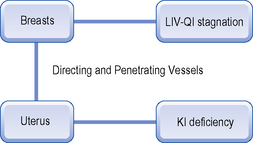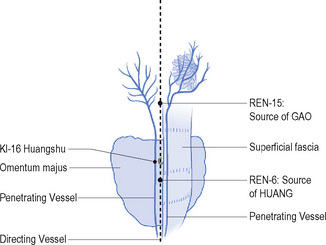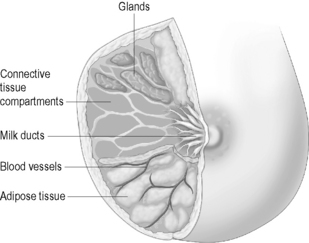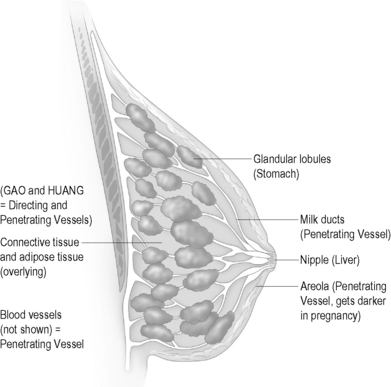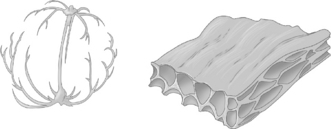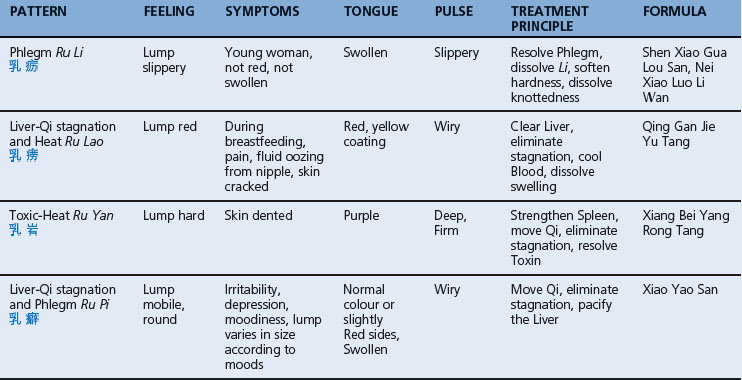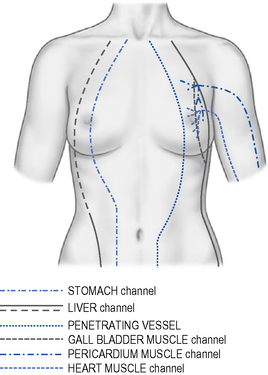CHAPTER 59 Breast Lumps
a lump (or lumps) in the breast which is like a plum seed or an egg or nodules which feel hard and are painless and mobile. The breast does not feel hot or cold to the touch, the skin colour is unchanged and the size of the lump varies according to the mood of the woman.1
The Discussion on the Origin of Diseases (Zhu Bing Yuan Hou Lun, AD 610) mentions hard breast nodules (called ru shi yong ![]() , i.e. ‘breast stone carbuncle’) that cannot be moved on palpation. It says: “The Stone Carbuncle is not very big, not red nor hot … it is an accumulation like a stone” and “There is a hidden accumulation in the breast without pain or itching.” Also: “There is an accumulation under the skin like a cow’s neck.” 2
, i.e. ‘breast stone carbuncle’) that cannot be moved on palpation. It says: “The Stone Carbuncle is not very big, not red nor hot … it is an accumulation like a stone” and “There is a hidden accumulation in the breast without pain or itching.” Also: “There is an accumulation under the skin like a cow’s neck.” 2
If it is not broken it can be treated, if it is broken it is difficult to treat. The earlier it is treated, the better. If it bursts inside it burns the flesh, it spreads to the internal organs and causes death.3
in the beginning there is a small accumulation like a turtle egg which is not red nor painful, after several months it gets bigger, then the lump breaks up like a ripe pomegranate, it bursts through like in a deep hole, this is due to Liver and Spleen being affected by anger, Qi and Blood are exhausted and it is called Ru Yan.4
Zhu Dan Xi (Yuan dynasty, 1281–1358) discussed the treatment of breast lumps in detail. He said:
Worry, anger and depression cause accumulation, Spleen-Qi is weakened, Liver-Qi free flow fails, there is a hidden nodule formed like an egg without pain or itching; after several years it forms an ulcer (chuang ![]() ) and it is called Ru Yan. It looks like an ulcer on the surface and is like a stone in a cavity, it cannot be treated.5
) and it is called Ru Yan. It looks like an ulcer on the surface and is like a stone in a cavity, it cannot be treated.5
In the beginning it is like a bean, then like an egg, without pain or itching, after one year pain develops. Then it grows into a heap, the skin becomes purple, then ulcers develop and the lump is like a rock, there is blood oozing from the nipple, then the five Yin organs are exhausted.6
A swelling of the breast with red nodules that lasts several days with pain and oozing of pus which then heals, is due to Toxic Heat in Stomach and Gall-Bladder with stagnation of Qi and Blood and it is called Breast Carbuncle: this is easy to treat. If inside the breast there are small nodules, not red, not swollen and not painful, but which last for months forming [a lump] like a rocky mountain, and then like a ripe pomegranate when they break, these are difficult to treat.8
Aetiology
Emotional problems
When a woman is worried and depressed, accumulation develops, Spleen-Qi becomes weak, Liver-Qi rebels horizontally, stagnant Qi turns into nodules like turtle eggs, there is no pain or itching. After ten years ulcers develop and the disease is called Ru Yan.9
The Orthodox Manual of External Diseases (Wai Ke Zheng Zong), written by Chen Shi Gong in 1617, mentions the Heart in connection with stagnation when it says: “Depression injures the Liver, pensiveness affects the Spleen, accumulation develops in the Heart, the channel-Qi stagnates and generates nodules.”10
Pathology and treatment principles
In terms of channels, the Directing and Penetrating Vessels are the most important ones in the development of breast lumps. Both Directing and Penetrating Vessels arise from the space between the kidneys, flow through the uterus and connect upward with the breasts (see Fig. 59.1).
The Directing and Penetrating Vessels also influence the formation of breast lumps in other ways, through the Gao (![]() ) and Huang (
) and Huang (![]() ) structures. Gao literally means ‘fat’ while Huang means ‘membranes’: the Source points for these two structures are both on the Directing Vessel. Chapter 1 of the Spiritual Axis mentions the Source points as being the following:
) structures. Gao literally means ‘fat’ while Huang means ‘membranes’: the Source points for these two structures are both on the Directing Vessel. Chapter 1 of the Spiritual Axis mentions the Source points as being the following:
The Spiritual Axis says literally: “The Source of Gao comes out at Jiuwei, one point. The Source of Huang comes out at Bo Yang, one point.”11 All Chinese texts and dictionaries say that Bo Yang is Ren-6 Qihai, but some people think it is Ren-8 Shenque. However, note that an alternative name for Ren-6 Qihai is ‘Xia Huang’, i.e. ‘Lower Membranes’: this would seem to confirm that the point Bo Yang mentioned in Chapter 1 of the Spiritual Axis is indeed Ren-6 Qihai (see also Ch. 7).
Gao (‘fat’) may refer to adipose tissue. An interesting aspect of this is that old Daoist texts on embryology say that in the first month, the fetus (or, more precisely, blastocyst) is just ‘Gao’ say that the fetus in the second month is ‘Gao’). Huang literally means ‘membranes’ and it refers to tissues surrounding and connecting the viscera. Chapter 40 of the Simple Questions mentions Huang:
Some people are affected by swelling of the large joints and abdominal pain around the umbilicus: what is the cause of this disease? [the Yellow Emperor asks] Chi Po answers: This disease is called Hardness of the Viscera and is due to Wind. When this overflows to the Large Intestine it reaches the Huang Membranes, the Source of the Huang Membranes is below the umbilicus and this causes pain around the umbilicus.12
The Classic of Categories (1624) says: “The gaps running up and down the abdomen in between the muscles of abdominal cavity are where the Huang Membranes are situated”.13 This last passage clearly seems to indicate that the Huang membranes are the connective tissue in the abdominal cavity that encapsulates and connects the viscera.
Thus, Gao and Huang represent a whole range of connective tissue including adipose tissue and abdominal connective tissue. They cover the whole body with a layer immediately below the skin and an inner layer wrapping and anchoring the organs, muscles and bones. In other words, Gao and Huang are all the structures that are not skin, muscles, sinews, blood vessels, bones or internal organs. When we refer to the tissues of the body related to the five main Yin organs, we normally include skin (Lungs), muscles (Spleen), sinews (Liver), bones (Kidneys) and vessels (Heart); however, if these were the only tissues, the organs would be situated in a vacuum unconnected to each other or to surrounding structures. We know from modern medicine that the connective tissue does indeed connect, i.e. it connects various structures of the body. In the abdominal cavity, Gao corresponds to adipose tissue and Huang to the connective tissue and the capsules surrounding the organs (Fig. 59.2). There are other types of connective tissues such as the tendons, which pertain to the ‘sinews’.
With reference to the two points Ren-15 and Ren-6 (or Ren-8), these are the Source of Gao and Huang, which means that these points and the whole Directing Vessel on the abdomen are embryologically related to the development of abdominal connective tissue. Using these points can therefore act at a deep energetic level to regulate and equalize tensions and weaknesses in the ‘membranes’ of the abdomen and thorax. In relation to the breast, this is rich in adipose tissue and connective tissue, the latter in the form of compartments that house the glandular lobules (see Fig. 59.3). Thus, both the Directing and Penetrating Vessels exert an important influence on the breast through the Gao and Huang structures (as well as in other ways). Figure 59.4 illustrates the relation between these two vessels and breast structures.
The Huang structures (and therefore the Directing and Penetrating Vessels) are also involved in the pathogenesis of breast cancer, even though this is a carcinoma, i.e. cancer of the epithelial tissue. In fact, in recent years researchers have suggested that some of the non-glandular supporting cells within the breast (made of connective tissue and therefore Huang) may influence the growth of cancer cells. These cells form part of the supporting structure of the breast and produce some chemical messengers called growth factors which seem to ‘communicate’ chemically with breast cancer cells to influence both their growth and their ability to spread.14
It is interesting to note that some of these herb names contain the words Luo for Connecting channels and Tong for ‘removing obstructions’. Moreover, the structure of these herbs when dried resembles a network of channels running in all directions, just as the network of Connecting channels does. In some of them, the structure even resembles the network of the breasts with its lobules, milk ducts and connective tissue compartments. In particular, Ju Luo Fibra Citri rubrum, i.e. the soft fibrous tissue lining the inside of the rind in tangerines, bears a close resemblance to the connective tissue inside the breast, and the whole fruit may be taken to represent the breast itself (see Fig. 59.5).
The main pathogenic conditions in breast lumps are therefore:
Diagnosis
Table 59.1 summarizes the different types of breast lumps, with their symptoms, tongue, pulse, treatment principle and prescription.
